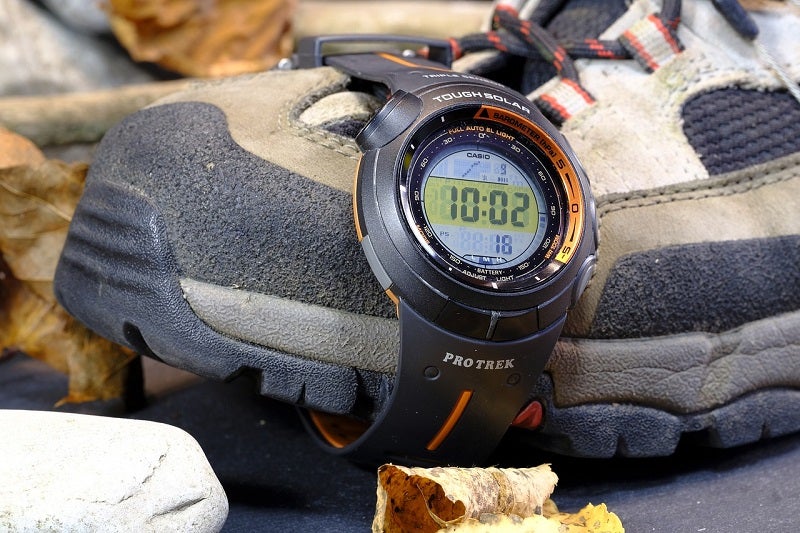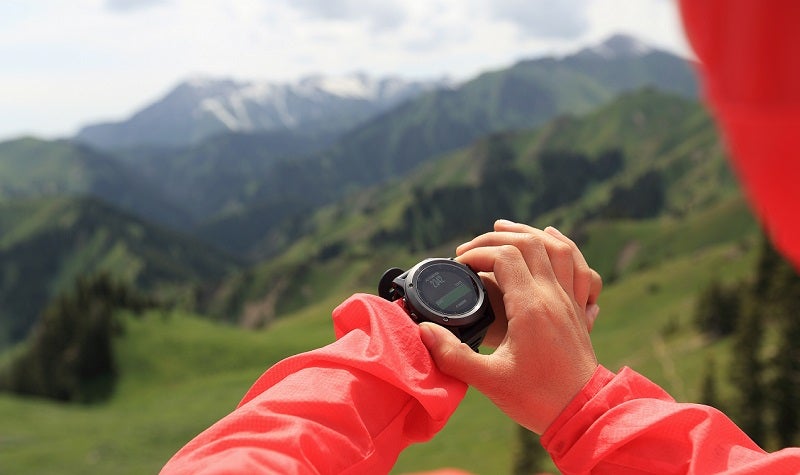
Our Editors independently research, test, and rate what we feel are the best products. We use affiliate links and may receive a small commission on purchases.
Part of being a safe hiker is understanding your environment and make predictions – such as changes in the weather. This is where an ABC hiking watch (Altimeter, Barometer, Compass) can be helpful.
Hikers now have many tools for jobs like this but for the active outdoor adventurer very few are as concise and useful as the top hiking watches now available.
With the advances in technology, you now can have GPS mapping technology on your wrist with the durability to go anywhere, even underwater.
Best Hiking Watches
For more of my hiking recommendations, have a look through these popular Outside Pursuits guide links: Hiking Compasses, Handheld GPS Units, Hiking Binoculars.
Quick Answer: The 7 Best Rated GPS Hiking Watches For 2021
- Garmin Fenix 6 Pro Premium
- Suunto Traverse GPS Watch
- Casio Pro Trek PRW-3500
- Suunto Core Outdoor Matrix Watch
- Garmin Foretrex 401 Hiking GPS
- Garmin Fenix 5 Plus Watch
- Casio Pathfinder Triple Sensor Watch
Our reviews of the top rated hiking watches with our comparison table and buying guide will help you choose the right watch for you.
GPS Hiking Watch Reviews
#1 Garmin Fenix 6 Pro Premium
- GPS: Yes
- Full ABC Functionality: Yes
- Thermometer: No
- Water Resistance: 100 Meters
- Other: Wrist Heart Rate, Activity & Sleep Tracking
If your looking for the best GPS hiking watch, look no further! This great-looking watch features a nice dark color scheme, sleek design, and some classic touches.
Screen resolution, graph display, colors, and layout are all superb which you would expect considering the hefty price tag.
Garmin has been making technical devices for years and their watches have definitely refined so we’re pretty confident in the long-term function of this hiking watch.
Integrated wrist-based heart rate provides real-time data to supplement the excellent GPS tracking to create excellent all-around tracking.
The one down side?
– the watch doesn’t have weather prediction capability but we’re pretty confident the other features offset this for the right users and many of you can look at the sky and make your predictions and decisions that way.
The bonus?
This watch can even provide GPS navigation in the backcountry and the watch can be updated with downloaded screens.
Yeah, that’s right, you can just download a new watch layout – just like that. This is by far the best GPS watch for hiking, you will never need to worry about getting lost again.
Pair this awesome watch wirelessly with your smart phone for notifications, even on the trail.
The 2-week long battery life is a serious improvement over early model Garmin watches and we think this awesome watch has all the capabilities to track, analyze, and display any information you need from climbing, skiing, running or even golfing!
If you can afford the extra money, the Garmin Fenix is the best hiking watch with its unmatched features.
#2 Suunto Traverse GPS Watch
- GPS: Yes
- Full ABC Functionality: Yes
- Thermometer: No
- Water Resistance: 100 Meters
- Other: Smartphone connectivity, compatible App
The Suunto Traverse, like the Garmin Fenix is a true ABC (Altimeter, Barometer, Compass) hiking watch that also includes a GPS function.
This watch has similar functions to the better-known Garmin Fenix.
With the edition of Suunto’s Movescout.com website and apps available for download, the Traverse is in a class by itself. The watch is equally useful for the backcountry hiker or the jogger wanting to keep track of their runs. It can also be beneficial to hunters and fishers thanks to its specific activity settings.
The Movescout.com allows you to upload your trips, routes, and all your fitness data while allowing you to download apps that either you can create or other people have created, all for free.
ABC Functionality
This is where the Traverse shines, it provides a very accurate altimeter that records data points and inputs them in real-time into the app.
The barometric data and all other data can be uploaded to Movescout.com for safekeeping.
The compass works at almost any angle, so unlike a magnetic compass, your wrist does not need to be level to get an accurate reading.
The heading of the compass shows in a clearly visible degrees format with an arrow that shows north. You will need to set declination manually, however.
GPS Function
You can use the Movescout.com to load points of interest into the watch and use the GPS to navigate to the points. The FindBack feature will help you navigate back to where you started.
Nice, now you never need to worry about getting lost! The Traverse also shows a digital map showing your path. If you like, you can log your speed, distance and route to Movescout.com. A great feature for runners or bikers!
The battery life of the Transverse is good but varies widely depending on if you choose to use the GPS or not. It can last anywhere from 10 to 100 hours with the GPS function turned on, and significantly more with it off – up to 14 days.
When you first take it out of the box you are prompted to set it up, just like the Garmin Fenix. Unless you have used a GPS hiking watch before you will probably have to consult the user’s manual or online help to configure the menus.
Unlike many ABC watches the Altimeter is accurate but even still will need to be frequently calibrated. The FusedAlti function that works with GPS can be used for calibration. The large, easy-to-use function buttons can be easily used to toggle between screens even with gloves on.
The display is clear and easy to read and has a backlight for use at night. The Traverse is somewhat bulky when compared to the Garmin Fenix but it is still comfortable to wear all day.
No matter what you need GPS for, hiking, biking, fishing or marathons, the Traverse is a great option. The watch is also rated for 100m so you could even use it for snorkeling or diving.
This is a good looking watch, suitable for everyday wearing, even when you’re not in the woods. Hard to go wrong with the Suunto Traverse hiking watch.
#3 Casio Men’s Pro Trek PRW-3500
- GPS: No
- Full ABC Functionality: Yes
- Thermometer: Yes
- Water Resistance: 200 Meters
- Other: 5 Daily Alarms, Solar recharging
At a reasonable price point and bristling with features like a hedgehog with quills, this watch might be the sweet spot for budget outdoor travelers.
Packing five alarms, solar power supplement, altimeter, compass, barometer, thermometer, and sunrise and set tables it’s hard to argue with this beast.
Battery life is reported to be off-the-charts good, rated at 7 months on a single charge. Keep in mind the solar charging feature means you can easily extend that battery life almost indefinitely.
Storm alarm is a great feature for any watch with a barometer and the Casio Protek doesn’t disappoint. It is one of the best backpacking watches on the market.
Easy to navigate one-touch menu system is great for quick access to critical and often-used features like the compass, barometer, and temperature.
Huge improvements to hardware over previous model Casio altimeter watches means you’ve got a candidate for “most improved” (if we were giving awards).
It’s hard to say what real tests would show but Casio claims as much as 90% power consumption reduction with new efficient hardware.
Video: This is a feature overview for the 3500, only difference from 3000 it has solar recharging.
My biggest complaint? The black, sleek design and display can sometimes be difficult to read. However, the watch has a handy “illuminate when held up” setting where the watch will automatically light up when it thinks you’re trying to look at it. Nifty!
In my opinion, it is the best backpacking watch and one of my top picks.
#4 Suunto Core Wrist Computer Watch
- GPS: No
- Full ABC Functionality: Yes
- Thermometer: Yes
- Water Resistance: 100 Meters
- Other: Depth meter
Unlike the Garmin, this watch lacks a GPS but gains a great barometer. This means weather tracking and storm alarms.
Granted, you can’t pair it with your smart phone or get notifications. The Suunto Core is for the disconnected mountaineer whereas the Fenix might be for the plugged-in active CEO.
Another cool feature is sunrise and sunset times around the world, why does it matter?
Because with features like storm predictions and sunset tables, you’ll be able to plan your hike or climb in a safe manner.
The wrist-mounted thermometer is temperature compensated to improve accuracy while the watch is on your wrist.
Even with compensation, I’ve never found watch thermometers to be very accurate unless you hang them from your tent overnight.
I think they could have included more than just a single alarm setting for the price, size, and tech included in this watch but that’s a minor complaint.
Overall the Core has been well loved in the industry for years – it’s hard to misstep with the Suunto Core. It is one of the best camping watches and you won’t go wrong with one on your wrist.
#5 Garmin Foretrex 401 Waterproof Hiking GPS
- GPS: Yes
- Full ABC Functionality: No, altimeter & compass
- Thermometer: No
- Water Resistance: Waterproof
- Other: Waypoints, optional heart rate monitor
While the Garmin Foretrex 401 is not a watch, strictly speaking, you can wear it on your wrist like a watch. Unlike the previously reviewed hiking watches, the Foretrek and be easily mounted on your bike, kayak or quad etc.
Like the previously reviewed Garmin Fenix, it has GPS capability with Garmin’s “TracBack” feature so you never have to worry about getting lost in the woods. It will literally show the path you took. Hansel and Gretel would be jealous, much better than breadcrumbs!
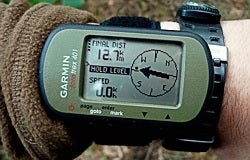
The high-sensitivity GPS receiver will work in the thickest of woods, unlike many other cheaper GPS units.
Even at a bargain price, Garmin has added features like a barometric altimeter giving you advance warning of a change in impending weather.
Plus it also functions as a compass when you’re just looking to figure out what direction is North.
I like the ability to save locations as waypoints allowing you to find your way back to important locations. If you’re a hunter or fisherman, this is a really nice feature when you find a good fishing spot!
Using standard replaceable AAA batteries with 17 hours of life is definitely a benefit in my book. When they get low, just pop in some new batteries and you’re good to go, no worrying about recharging or dead batteries.
While I wouldn’t wear the Garmin Foretrek 401 to work or out to dinner like I would the Fenix 3, its probably the best mountaineering watch!
#6 Garmin Fenix 5 Plus
- GPS: Yes
- Full ABC Functionality: Yes
- Thermometer: No
- Water Resistance: 100 Meters
- Other: Pre-loaded topographic maps, 3-axis compass, Bluetooth, ANT+, Wi-Fi
The times, they are a-changing. Garmin has been a leader in outdoor tech for years and their refinement is beginning to pay off (for them and for us)!
Their Fenix 5 is the latest in a line of oober-smart backcountry wrist computers that will knock your socks off.
Wrist-mounted GPS units have been surging in capability for years but I personally feel they’re just now beginning to really work out the bugs and fly under their own power.
Literally powering and keeping powered a GPS watch has long been an issue but little steps in the right direction have brought us to the Fenix 5 which has 8 hours of GPS capability on a single charge (or 10 days of smartwatch features).
We all know tech companies gather data and we hope they use it altruistically. In this case, Garmin has brought us AI that “uses billions of miles of Garmin Connect data to help you find and follow the best trails and routes”.
Basically, the watch knows where other people have hiked, biked, and run and it helps you stay on your bath by guessing where others went before you!
Of course, the watch is also loaded with a full suite of smartwatch capabilities like Bluetooth, notifications, reminders, text messages, emails – the whole 9 yards.
You also get onboard hardware that is capable of interfacing with GPS, GLONASS, and Galileo satellites as well as a 3-axis compass, barometer, and altimeter.
When all is said and done, suffice it to say that if you’re willing to shell out the cash the Garmin Fenix 5 may be the smartest, longest-lasting, and most intelligent hiking watch ever created.
#7 Casio Pathfinder Triple Sensor Multi-Function
- GPS: No
- Full ABC Functionality: Yes
- Thermometer: Yes
- Water Resistance: 100 Meters
- Other: Solar charging
Casio has a habit of delivering good digital watches with just the functions we need in the backcountry and nothing else.
This keeps them in a great price range for most users while still making good on the promise of hiking tech right at your fingertips.
In order to make our list of hiking watches, each of these wrist computers needs to supplement your hiking trip with powerful tools. In this case, you get full use of the compass, thermometer, altimeter, and barometer.
For several reasons I’ve already mentioned in this article, I feel the compass is likely the most useful of these features.
Pro Tip: Calibrate your compass, barometer, and altimeter often in order to ensure their accuracy.
One of the more advanced features of this particular watch is the dual-layer LCD. this means you get a robust visual display of compass bearings, graphical display of altitude and pressure, and other features.
Like some of Casio’s other high-end watches, this watch automatically turns on the backlight when it senses that you’re tipping your wrist into a position to look at the watch’s face.
Perhaps the most overlooked feature on this solar-powered watch is the battery life indicator that tells you when it’s time to find some sunlight!
Best for a watch that keeps itself running for months while providing you with the tools you need to supplement backcountry navigation.
Hiking Watch Comparison Table
| Hiking Watch | GPS | Altimeter | Barometer | Compass | Heart Rate Monitor | Rating | |
|---|---|---|---|---|---|---|---|
| Garmin Fenix 6 Pro Premium | Yes | Yes | Yes | Yes | Yes | 4.4 / 5.0 | |
| Suunto Transverse | Yes | Yes | Yes | Yes | Yes | 4.4 / 5.0 | |
| Casio PRW-3500-1CR | No | Yes | Yes | Yes | No | 3.7 / 5.0 | |
| Suunto Core Wrist Computer | No | Yes | Yes | Yes | No | 3.6 / 5.0 | |
| Garmin Foretrex 401 | Yes | Yes | Yes | Yes | No | 4.5 / 5.0 | |
| Garmin Fenix 5 Plus | Yes | Yes | Yes | Yes | Yes | 4.2 / 5.0 | |
| Casio Pathfinder Triple Sensor | No | Yes | Yes | Yes | No | 4.4 / 5.0 |
How to Choose the Best Hiking Watch – Buyers Guide
- Features
- The ABC’s
- User Interface
- Display Quality
- Extra Features
- Time Telling
- FAQs For Hiking Watches
- Final Thoughts
Features
Today, outdoor watches are becoming more feature robust and you may find all sorts of useful features. These include things like:
- Time / Date
- Stop Watch
- Storm Graphs
- Storm Alarms
- WiFi Connectivity
- Heart Rate Monitor
- GPS
- Thermometer
We’ll look at which of these features are available in our watches we review and let you know the good, bad, and ugly.
The ABC’s – Altimeter, Barometer, Compass
We are not referring to the alphabet here but the 3 primary functions of a mountaineering watch.
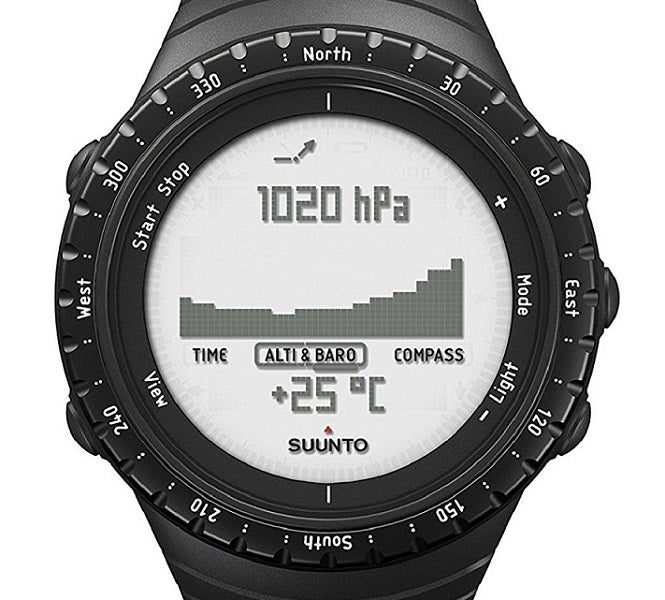
Altimeter
Even when you’ve got that topo out in front of you, it can be a great confirmation to know exactly what your current elevation is when you’re trying to locate your position.
Having an altimeter is ofter a good check on your GPS for checking your altitude because you may not be able to get a signal, especially if you’re in a canyon or thick trees.
The altimeter can be fun to check out for your own curiosity, for training data, or additional location information. Accuracy and adjustability is important in an altimeter.
Some watches have the ability to upload data to your computer – this can be fun for the gear junkie and number cruncher!
Barometer
Barometers can be finicky and accuracy is even more critical here. These tools are very touchy and prone to needing adjustment regularly but improvements in the field have been made!
Accurate barometers are critical to weather prediction for these watches so the more sensitive the barometer, the better for prediction. Trends and data retention are great for predicting upcoming movements.
Compass
Compasses in watches are an amazing feature! Of all the features available in hiking watches, the compass is my most used and favorite feature.
Having a 2D compass means that you must hold the watch totally flat to get an accurate reading. A 3D compass is accurate no matter the angle of your wrist. When it comes to investing in a compass tool, finding a 3D compass is always best!
User Interface
User interface is everything from the number of menus, number of screens, and customizable features. Some watches allow you to modify the display and change which data you want to see on your home screen.
You may even find that some watches just don’t show you the information you want in a way that appeals to you. It’s important to find a layout you can read quickly and comfortably to gather all your data.
Display Quality
Many watches have low resolution and poor display view, the more refined watches feature great resolution which means more accurate graph displays and easier to read data.
The better the resolution, the easier it will be to read smaller or tighter data and words on these small screens. It really does make a difference.
Durability
Along with water resistance you need to consider the durability of the watch. Look for a quality band and if you don’t want the lens of the watch getting scratched, consider going with a watch that has a sapphire lens like the Garmin Fenix.
Saphire is almost impossible to scratch or chip unlike a standard crystal lens in more inexpensive watches.
Water Resistance
No doubt a feature you must have on a hiking watch, you don’t want it getting ruined by a rainstorm or dropping it in the water. All outdoor watches on our list are water-resistant, the only difference is to what depth you use them.
Being able to take them to depth makes them useful for swimming, shallow diving and snorkeling.
Extras
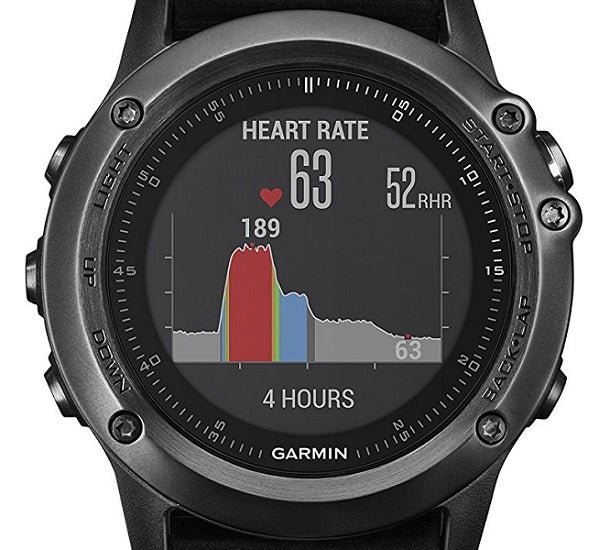
GPS
Another feature not found on every watch and arguably the most useful. Being able to track where you are and where you are going with your watch is truly amazing!
Having a GPS can give your more confidence in the woods knowing that you will not get lost and be able to find your destination. Plus you can track, your speed, distance, elevation and location for future reference.
Thermometer
Not all outdoor hiking watches have this useful feature. To get an accurate temperature I would recommend taking the watch off and checking the temperature because your body may influence the reading.
WiFi Connectivity
No, there probably isn’t too much use for this feature while you’re hiking unless you’re bringing your laptop along with you in the woods. But it will allow you to easily connect to it and the internet to upload your data so you can get a detailed overview of your hiking trip.
It may also allow updating the firmware and downloading maps and new/updated features onto your watch.
Heart Rate Monitor
Several hiking watches on our list will also tell you your heart rate. This can help you maintain a steady pace by not getting too far above your target rate. Also useful if you are training for a Triathlon or just interested to see how your fitness level is improving.
Time Telling
Of course, watches should tell time but you’d be surprised – some companies sell “wrist computers” which actually lack a time feature.
Other things which fall in this category are countdown times, alarms, and stopwatch features such as splits. Having a countdown timer is always nice for making sure you check on the pizza in the oven at the ski hut, too…
Budget
Lastly, we need to look at the cost! You will find a WIDE range of prices for hiking watches. Leaving out the feature of GPS, you’re looking at between $150 to $200. If you add in GPS (which you probably should) the price jumps up over $300+.
If you already have a hiking GPS or feel comfortable using just a compass and map, you can leave out this feature. But consider how useful it will be, being able to track your position real time by just looking at your wrist!
FAQs About Hiking Watches
Q: Does cold weather affect hiking watch battery life?
A: Yep. It does.
Unfortunately, the simple truth is that extreme cold will kill batteries. Fast! To help with this problem there are a couple tricks you can use to improve run time.
First, use your body’s natural warmth to keep the battery alive longer. Your arm is putting off almost 100 degrees of heat! Pull your sleeves or gloves up over the watch to keep it warm longer. If your watch is sticking out between your cuff and glove, expect it to get cold and die faster.
Second, try taking your watch off your wrist and putting it somewhere warmer. This would be somewhere like an inside pocket! Look for a pocket on the inner layer of clothing you’re wearing like an inside coat pocket, breast pocket, or napoleon check pocket.
Q: Is my hiking watch compass broken!?!?
A: Probably not. But it’s likely you’re using it wrong.
If you think your compass isn’t working right on your hiking watch check for a couple of things.
Be sure you’re away from magnetic objects or metal interference. Things like:
- Large metal objects
- Cars
- Buildings
- Power lines
- Other powerful electronic devices
… these can all interfere with the compass on your watch and cause all sorts of chaos! Move well away from them and try again.
If that doesn’t solve the problem, try calibrating your watch compass. This usually involves some combination of button presses and then spinning in circles with the watch held flat.
Lastly, and similar, is to make sure you’re using the compass correctly on the watch!
2-axis compasses must be held perfectly flat to work. If they’re not flat, you’ll never get a proper reading.
3-axis compasses can be held in any orientation and function fine. These are always quite a bit more expensive though.
Q: What’s up with the barometer on my hiking watch?
A: Depending on your watch, the quality, and how well it’s designed barometers in my experience can either be helpful or wildly inaccurate.
First of all, make sure your barometer is calibrated. The only way to do this is to check your user manual and follow the directions. You’ll have to also get an accurate barometric pressure reading for the exact area you’re in to do this.
Most weather reports will include a recent, accurate barometric pressure. However, if you’re in the mountains and the weather reports pressure from a station at 7,000 feet and you’re at 8,500 setting your watch, it will be way off.
I’ll be totally honest. For the several years I wore a hiking watch with a barometer I never found a way to keep it accurate and calibrated reliably. It always felt like a hassle.
Q: What type of watch band is the best for my watch?
A: Essentially you get to pick from three materials:
- Leather
- Fabric
- Rubber
I personally think rubber is the best. It’s waterproof and durable. I’ve never seen rubber watch bands fail and they seem to keep on chugging forever.
Fabric watch bands tend to get gunky over time. They get filled in with dead skin cells and other nastiness which eventually looks, feels, and smells narsty! When you get wet, the watch band will get wet and stay wet. They are pretty durable though.
Leather works fine, too. However, nice leather watch bands are expensive and exposure to chemicals, water, and gunk over time just beats them up. They also tend to absorb water and stay wet a long time if you go for a dunk.
I like rubber watch bands, myself.
Q: How long can my battery last?
A: The only way to know this for sure is to get one and try it.
However, the next best thing is to use online reviews. You can find good reviews of almost any popular hiking watch around the web and many of them will include detailed information about battery run time.
This will depend, of course, on several factors. We already talked about cold weather, but your use of features like GPS, compass, and other battery consuming functions may dramatically change battery life.
Many of these watches can be handily recharged with those battery packs you can buy cheap on Amazon. This is annoying to do in the middle of a multi-pitch ascent, though!
Q: Do I need a GPS watch for hiking?
A: If you want the safety of GPS for navigation with the convenience of having it on your wrist then yes you need a GPS watch. The alternative is a larger handheld hiking GPS that can clip on your backpack or pocket.
Final Thoughts
There are tons of watches in this niche and more every month. Determine your needs, such as length of battery life, type of features, and whether or not you think you’ll want to pair your watch with a phone.
Everyone has a different style and needs so take these into consideration before choosing a watch.
Out of all of our watches reviewed, I have to give the Casio Protek top marks for versatility and price, but I think the refined and trusted features of the Suunto Core are worth spending a few extra bucks.
For the high-spenders, it’s really hard to argue with the beautiful and robust Garmin Fenix 3 but the biggest drawback is the relatively shorter battery life which might be a problem for some serious backcountry travelers.
Enjoy the mountains and look for a watch that can keep up with your pace!
I hope this guide was helpful for finding a good hiking watch to fit your needs. If you want to comment or recommend a watch I didn’t include, please use my contact form to get in touch.
Have fun and be safe out there!


